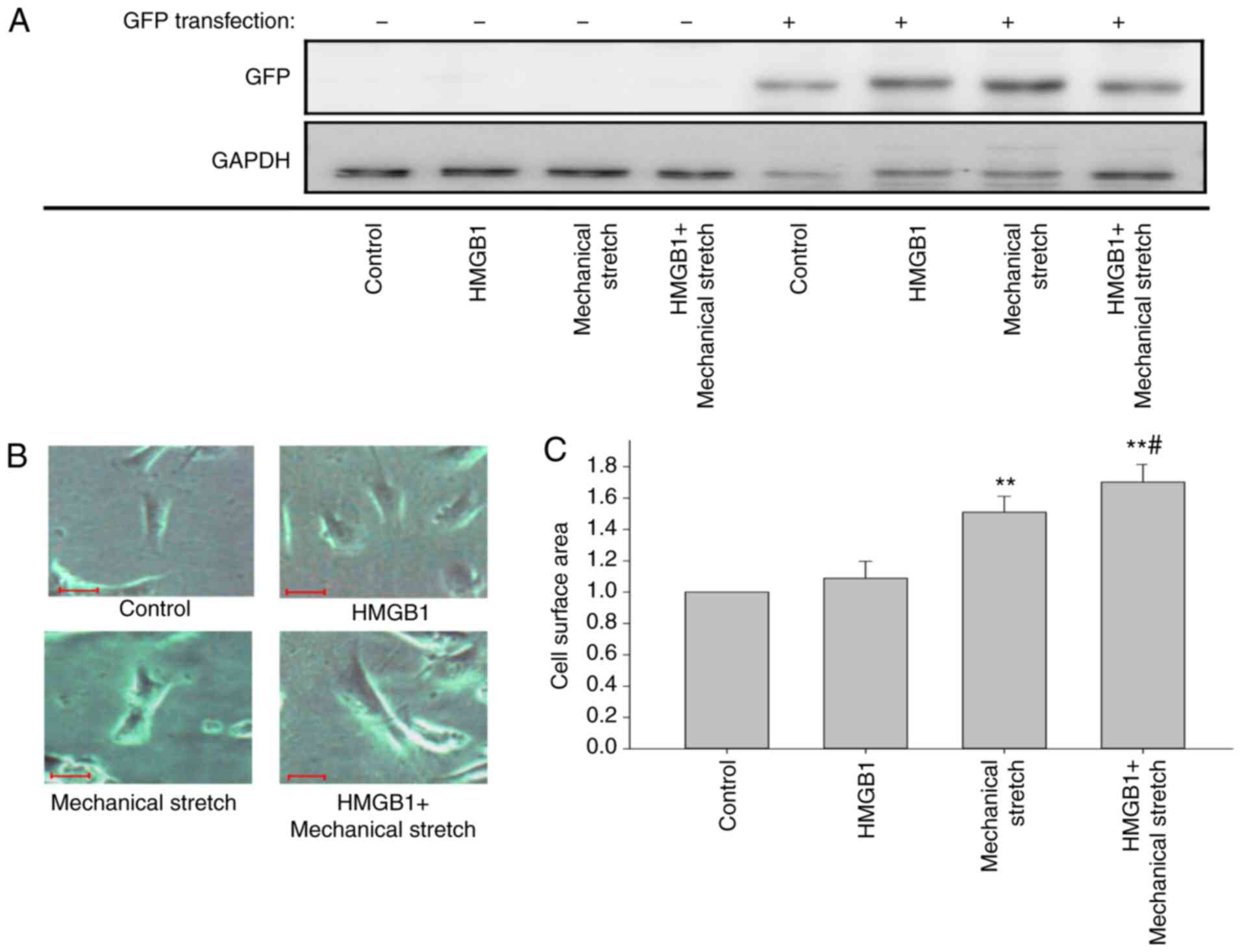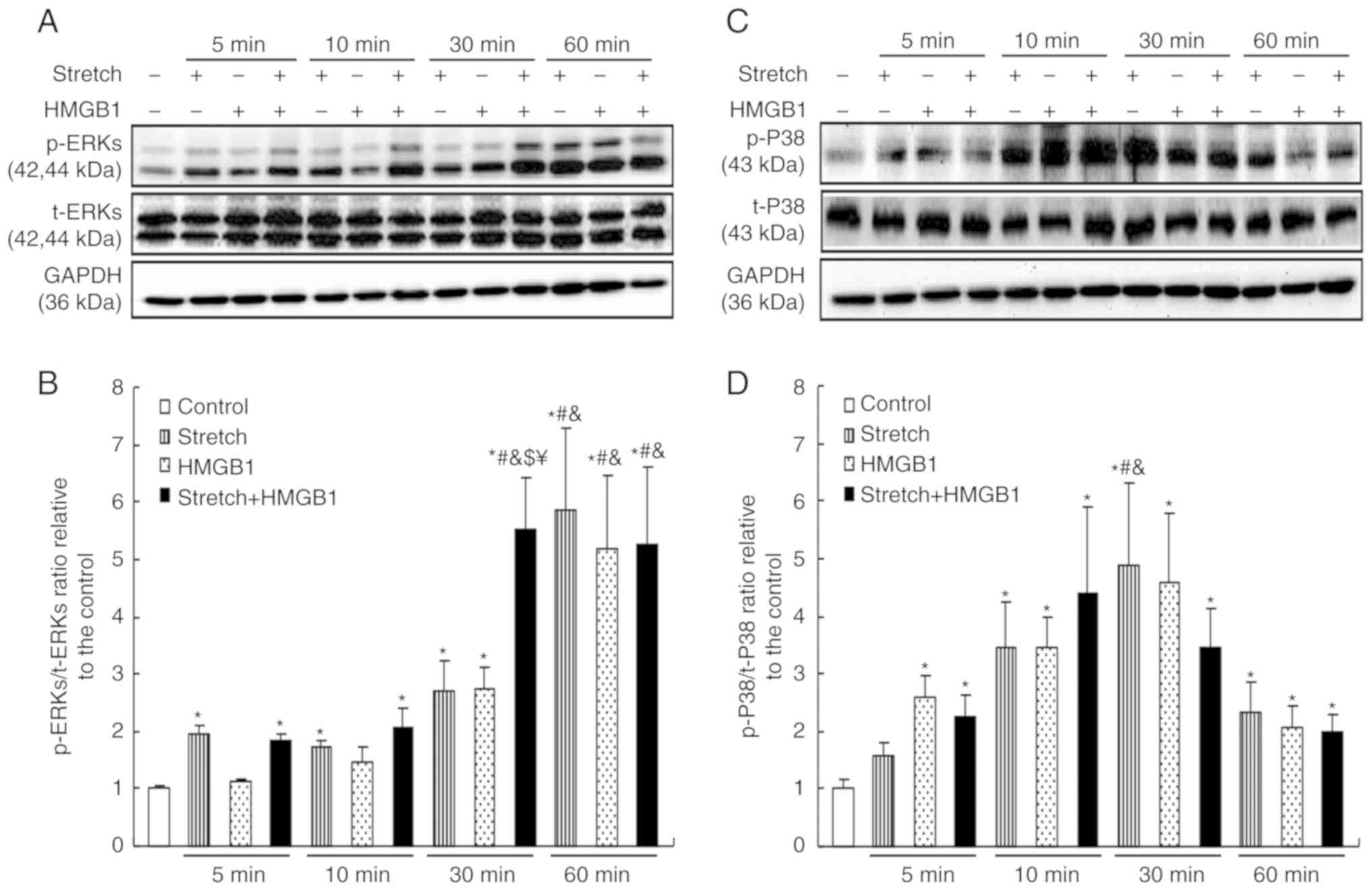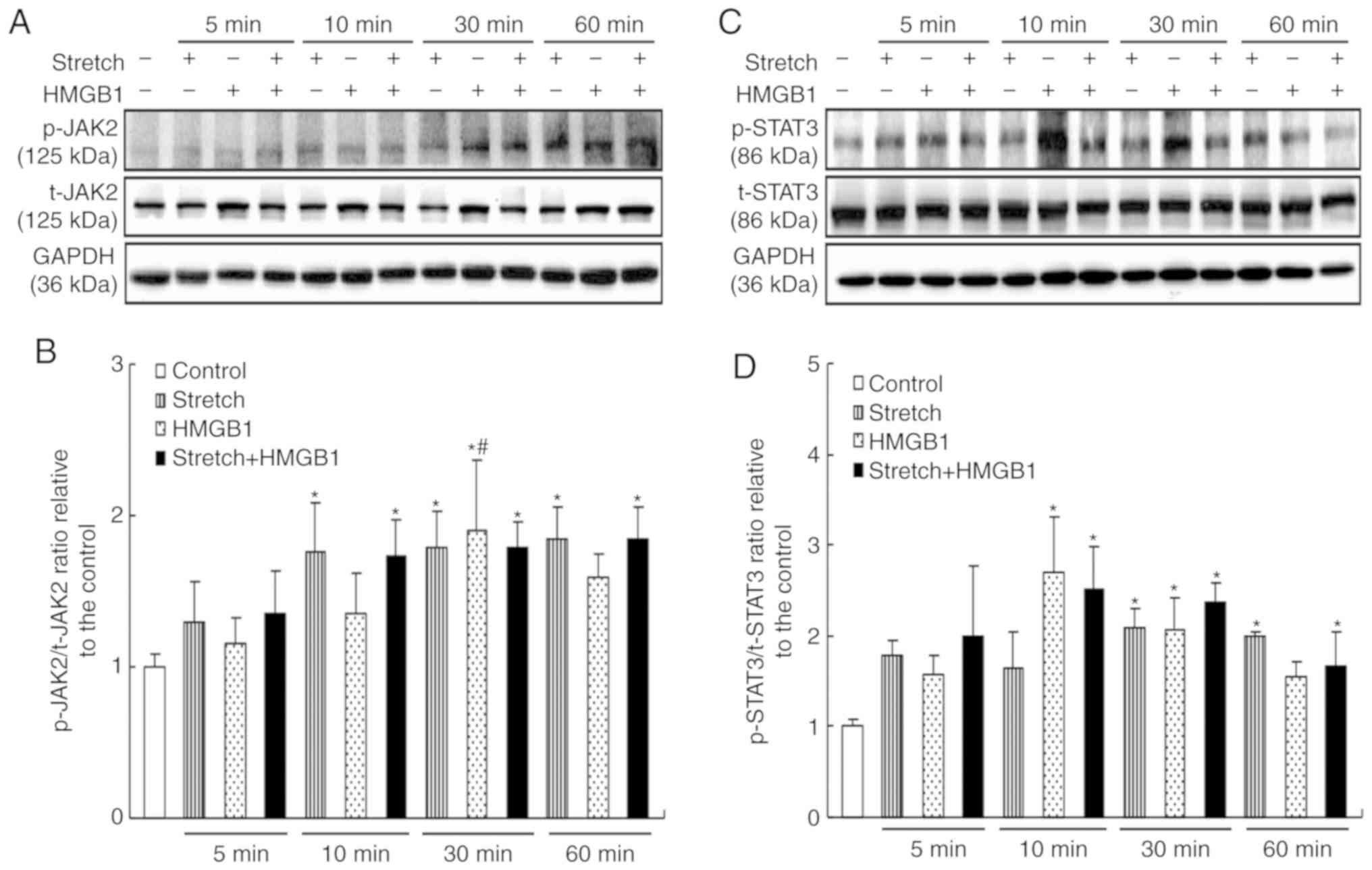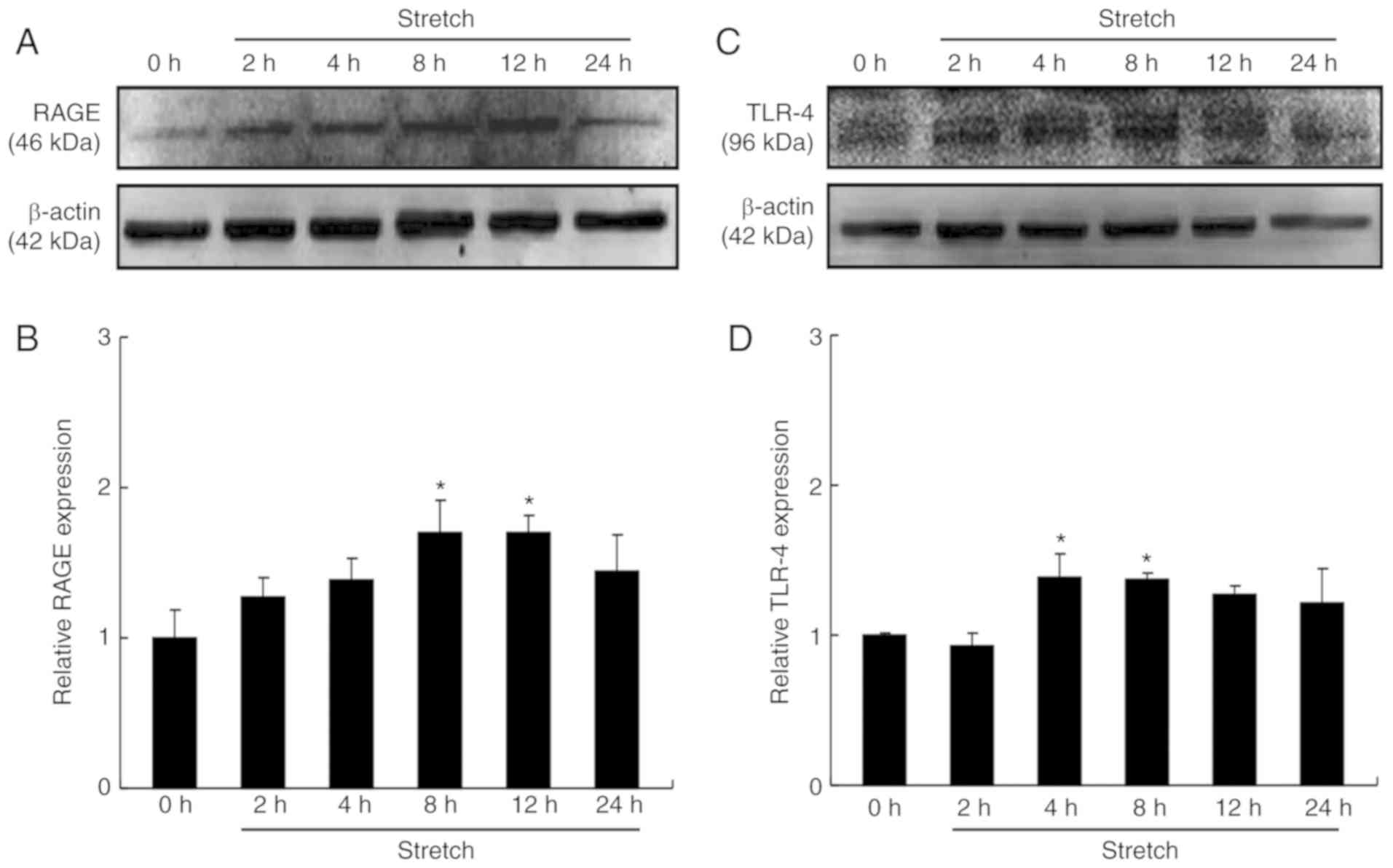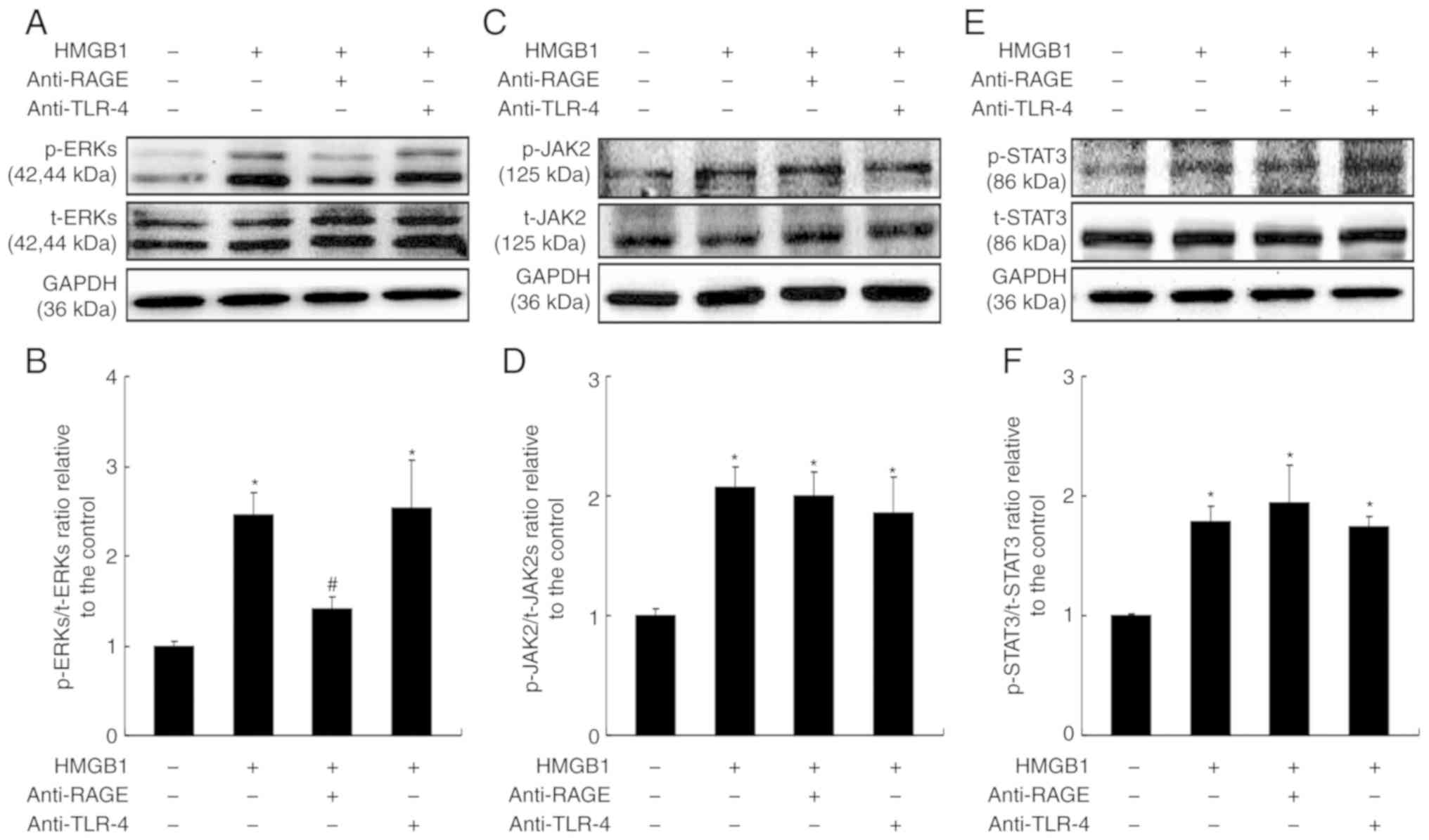|
1
|
Tham YK, Bernardo BC, Ooi JY, Weeks KL and
McMullen JR: Pathophysiology of cardiac hypertrophy and heart
failure: Signaling pathways and novel therapeutic targets. Arch
Toxicol. 89:1401–1438. 2015. View Article : Google Scholar : PubMed/NCBI
|
|
2
|
Kwon HK, Jeong H, Hwang D and Park ZY:
Comparative proteomic analysis of mouse models of pathological and
physiological cardiac hypertrophy, with selection of biomarkers of
pathological hypertrophy by integrative Proteogenomics. Biochim
Biophys Acta Proteins Proteom 30118-30123. Jul 23–2018.Epub ahead
of print. View Article : Google Scholar
|
|
3
|
Higashikuni Y, Tanaka K, Kato M, Nureki O,
Hirata Y, Nagai R, Komuro I and Sata M: Toll-like receptor-2
mediates adaptive cardiac hypertrophy in response to pressure
overload through interleukin-1beta upregulation via nuclear factor
kappaB activation. J Am Heart Assoc. 2:pp. e0002672013, View Article : Google Scholar
|
|
4
|
Verma SK, Krishnamurthy P, Barefield D,
Singh N, Gupta R, Lambers E, Thal M, Mackie A, Hoxha E, Ramirez V,
et al: Interleukin-10 treatment attenuates pressure
overload-induced hypertrophic remodeling and improves heart
function via signal transducers and activators of transcription
3-dependent inhibition of nuclear factor-kappaB. Circulation.
126:418–429. 2012. View Article : Google Scholar : PubMed/NCBI
|
|
5
|
Sun M, Chen M, Dawood F, Zurawska U, Li
JY, Parker T, Kassiri Z, Kirshenbaum LA, Arnold M, Khokha R and Liu
PP: Tumor necrosis factor-alpha mediates cardiac remodeling and
ventricular dysfunction after pressure overload state. Circulation.
115:1398–1407. 2007. View Article : Google Scholar : PubMed/NCBI
|
|
6
|
Andersson U and Tracey KJ: HMGB1 is a
therapeutic target for sterile inflammation and infection. Annu Rev
Immunol. 29:139–162. 2011. View Article : Google Scholar : PubMed/NCBI
|
|
7
|
Kang R, Chen R, Zhang Q, Hou W, Wu S, Cao
L, Huang J, Yu Y, Fan XG, Yan Z, et al: HMGB1 in health and
disease. Mol Aspects Med. 40:1–116. 2014. View Article : Google Scholar : PubMed/NCBI
|
|
8
|
Zhang L, Liu M, Jiang H, Yu Y, Yu P, Tong
R, Wu J, Zhang S, Yao K, Zou Y and Ge J: Extracellular
high-mobility group box 1 mediates pressure overload-induced
cardiac hypertrophy and heart failure. J Cell Mol Med. 20:459–470.
2016. View Article : Google Scholar
|
|
9
|
Nakamura M and Sadoshima J: Mechanisms of
physiological and pathological cardiac hypertrophy. Nat Rev
Cardiol. 15:387–407. 2018. View Article : Google Scholar : PubMed/NCBI
|
|
10
|
Shimizu I and Minamino T: Physiological
and pathological cardiac hypertrophy. J Mol Cell Cardiol.
97:245–262. 2016. View Article : Google Scholar : PubMed/NCBI
|
|
11
|
Liu R and Molkentin JD: Regulation of
cardiac hypertrophy and remodeling through the dual-specificity
MAPK phosphatases (DUSPs). J Mol Cell Cardiol. 101:44–49. 2016.
View Article : Google Scholar : PubMed/NCBI
|
|
12
|
Ruppert C, Deiss K, Herrmann S, Vidal M,
Oezkur M, Gorski A, Weidemann F, Lohse MJ and Lorenz K:
Interference with ERK(Thr188) phosphorylation impairs pathological
but not physiological cardiac hypertrophy. Proc Natl Acad Sci USA.
110:7440–7445. 2013. View Article : Google Scholar : PubMed/NCBI
|
|
13
|
Heineke J and Molkentin JD: Regulation of
cardiac hypertrophy by intracellular signalling pathways. Nat Rev
Mol Cell Biol. 7:589–600. 2006. View
Article : Google Scholar : PubMed/NCBI
|
|
14
|
Yuan L, Qiu L, Ye Y, Wu J, Wang S, Wang X,
Zhou N and Zou Y: Heat-shock transcription factor 1 is critically
involved in the ischaemia-induced cardiac hypertrophy via
JAK2/STAT3 pathway. J Cell Mol Med. 22:4292–4303. 2018. View Article : Google Scholar : PubMed/NCBI
|
|
15
|
Andrassy M, Volz HC, Igwe JC, Funke B,
Eichberger SN, Kaya Z, Buss S, Autschbach F, Pleger ST, Lukic IK,
et al: High-mobility group box-1 in ischemia-reperfusion injury of
the heart. Circulation. 117:3216–3226. 2008. View Article : Google Scholar : PubMed/NCBI
|
|
16
|
Mir SA, Chatterjee A, Mitra A, Pathak K,
Mahata SK and Sarkar S: Inhibition of signal transducer and
activator of transcription 3 (STAT3) attenuates interleukin-6
(IL-6)-induced collagen synthesis and resultant hypertrophy in rat
heart. J Biol Chem. 287:2666–2677. 2012. View Article : Google Scholar :
|
|
17
|
Hou T, Tieu BC, Ray S, Recinos A Iii, Cui
R, Tilton RG and Brasier AR: Roles of IL-6-gp130 signaling in
vascular inflammation. Curr Cardiol Rev. 4:179–192. 2008.
View Article : Google Scholar : PubMed/NCBI
|
|
18
|
Fritz G: RAGE: A single receptor fits
multiple ligands. Trends Biochem Sci. 36:625–632. 2011. View Article : Google Scholar : PubMed/NCBI
|
|
19
|
Herzog C, Lorenz A, Gillmann HJ, Chowdhury
A, Larmann J, Harendza T, Echtermeyer F, Müller M, Schmitz M,
Stypmann J, et al: Thrombomodulin's lectin-like domain reduces
myocardial damage by interfering with HMGB1-mediated TLR2
signalling. Cardiovasc Res. 101:400–410. 2014. View Article : Google Scholar
|
|
20
|
Narayanan KB and Park HH:
Toll/interleukin-1 receptor (TIR) domain-mediated cellular
signaling pathways. Apoptosis. 20:196–209. 2015. View Article : Google Scholar : PubMed/NCBI
|
|
21
|
Orliaguet G, Vivien B, Langeron O,
Bouhemad B, Coriat P and Riou B: Minimum alveolar concentration of
volatile anesthetics in rats during postnatal maturation.
Anesthesiology. 95:734–739. 2001. View Article : Google Scholar : PubMed/NCBI
|
|
22
|
Tsukamoto A, Konishi Y, Kawakami T,
Koibuchi C, Sato R, Kanai E and Inomata T: Pharmacological
properties of various anesthetic protocols in 10-day-old neonatal
rats. Exp Anim. 66:397–404. 2017. View Article : Google Scholar : PubMed/NCBI
|
|
23
|
Zhang L, Jiang H, Gao X, Zou Y, Liu M,
Liang Y, Yu Y, Zhu W, Chen H and Ge J: Heat shock transcription
factor-1 inhibits H2O2-induced apoptosis via down-regulation of
reactive oxygen species in cardiac myocytes. Mol Cell Biochem.
347:21–28. 2011. View Article : Google Scholar
|
|
24
|
Ehler E, Moore-Morris T and Lange S:
Isolation and culture of neonatal mouse cardiomyocytes. J Vis Exp.
2013. View Article : Google Scholar : PubMed/NCBI
|
|
25
|
Zhou N, Li L, Wu J, Gong H, Niu Y, Sun A,
Ge J and Zou Y: Mechanical stress-evoked but angiotensin
II-independent activation of angiotensin II type 1 receptor induces
cardiac hypertrophy through calcineurin pathway. Biochem Biophys
Res Commun. 397:263–269. 2010. View Article : Google Scholar : PubMed/NCBI
|
|
26
|
Sadoshima J, Jahn L, Takahashi T, Kulik TJ
and Izumo S: Molecular characterization of the stretch-induced
adaptation of cultured cardiac cells. An in vitro model of
load-induced cardiac hypertrophy J Biol Chem. 267:10551–10560.
1992.
|
|
27
|
Zou Y, Akazawa H, Qin Y, Sano M, Takano H,
Minamino T, Makita N, Iwanaga K, Zhu W, Kudoh S, et al: Mechanical
stress activates angiotensin II type 1 receptor without the
involvement of angiotensin II. Nat Cell Biol. 6:499–506. 2004.
View Article : Google Scholar : PubMed/NCBI
|
|
28
|
Kokkola R, Andersson A, Mullins G, Ostberg
T, Treutiger CJ, Arnold B, Nawroth P, Andersson U, Harris RA and
Harris HE: RAGE is the major receptor for the proinflammatory
activity of HMGB1 in rodent macrophages. Scand J Immunol. 61:1–9.
2005. View Article : Google Scholar : PubMed/NCBI
|
|
29
|
Tzeng HP, Fan J, Vallejo JG, Dong JW, Chen
X, Houser SR and Mann DL: Negative inotropic effects of
high-mobility group box 1 protein in isolated contracting cardiac
myocytes. Am J Physiol Heart Circ Physiol. 294:H1490–H1496. 2008.
View Article : Google Scholar : PubMed/NCBI
|
|
30
|
Beetz N, Rommel C, Schnick T, Neumann E,
Lother A, Monroy-Ordonez EB, Zeeb M, Preissl S, Gilsbach R,
Melchior-Becker A, et al: Ablation of biglycan attenuates cardiac
hypertrophy and fibrosis after left ventricular pressure overload.
J Mol Cell Cardiol. 101:145–155. 2016. View Article : Google Scholar : PubMed/NCBI
|
|
31
|
Su FF, Shi MQ, Guo WG, Liu XT, Wang HT, Lu
ZF and Zheng QS: High-mobility group box 1 induces
calcineurin-mediated cell hypertrophy in neonatal rat ventricular
myocytes. Mediators Inflamm. 2012:8051492012. View Article : Google Scholar : PubMed/NCBI
|
|
32
|
Zhao L, Cheng G, Jin R, Afzal MR, Samanta
A, Xuan YT, Girgis M, Elias HK, Zhu Y, Davani A, et al: Deletion of
Interleukin-6 Attenuates pressure overload-induced left ventricular
hypertrophy and dysfunction. Circ Res. 118:1918–1929. 2016.
View Article : Google Scholar : PubMed/NCBI
|
|
33
|
Shyu KG, Wang BW, Wu GJ, Lin CM and Chang
H: Mechanical stretch via transforming growth factor-beta1
activates microRNA208a to regulate endoglin expression in cultured
rat cardiac myoblasts. Eur J Heart Fail. 15:36–45. 2013. View Article : Google Scholar
|
|
34
|
Chua S, Lee FY, Chiang HJ, Chen KH, Lu HI,
Chen YT, Yang CC, Lin KC, Chen YL, Kao GS, et al: The
cardioprotective effect of melatonin and exendin-4 treatment in a
rat model of cardiorenal syndrome. J Pineal Res. 61:438–456. 2016.
View Article : Google Scholar : PubMed/NCBI
|
|
35
|
Hou M, Gu HC, Wang HH, Liu XM, Zhou CL,
Yang Q, Jiang ZR, Lin J, Wu YM, Wu YT, et al: Prenatal exposure to
testosterone induces cardiac hypertrophy in adult female rats
through enhanced Pkcdelta expression in cardiac myocytes. J Mol
Cell Cardiol. 128:1–10. 2019. View Article : Google Scholar : PubMed/NCBI
|
|
36
|
Mohan N, Kumar V, Kandala DT, Kartha CC
and Laishram RS: A Splicing-independent function of RBM10 controls
specific 3′ UTR processing to regulate cardiac hypertrophy. Cell
Rep. 24:3539–3553. 2018. View Article : Google Scholar : PubMed/NCBI
|
|
37
|
Cheng KC, Chang WT, Kuo FY, Chen ZC, Li Y
and Cheng JT: TGR5 activation ameliorates hyperglycemia-induced
cardiac hypertrophy in H9c2 cells. Sci Rep. 9:36332019. View Article : Google Scholar : PubMed/NCBI
|
|
38
|
Schirone L, Forte M, Palmerio S, Yee D,
Nocella C, Angelini F, Pagano F, Schiavon S, Bordin A, Carrizzo A,
et al: A review of the molecular mechanisms underlying the
development and progression of cardiac remodeling. Oxid Med Cell
Longev. 2017:39201952017. View Article : Google Scholar : PubMed/NCBI
|
|
39
|
Komuro I: Molecular mechanism of cardiac
hypertrophy and development. Jpn Circ J. 65:353–358. 2001.
View Article : Google Scholar : PubMed/NCBI
|
|
40
|
Kacimi R and Gerdes AM: Alterations in G
protein and MAP kinase signaling pathways during cardiac remodeling
in hypertension and heart failure. Hypertension. 41:968–977. 2003.
View Article : Google Scholar : PubMed/NCBI
|
|
41
|
Gutkind JS and Offermanns S: A new
G(q)-initiated MAPK signaling pathway in the heart. Dev Cell.
16:163–164. 2009. View Article : Google Scholar : PubMed/NCBI
|
|
42
|
Reyes DRA, Gomes MJ, Rosa CM, Pagan LU,
Zanati SG, Damatto RL, Rodrigues EA, Carvalho RF, Fernandes AAH,
Martinez PF, et al: Exercise during transition from compensated
left ventricular hypertrophy to heart failure in aortic stenosis
rats. J Cell Mol Med. 23:1235–1245. 2019. View Article : Google Scholar :
|
|
43
|
Kojonazarov B, Novoyatleva T, Boehm M,
Happe C, Sibinska Z, Tian X, Sajjad A, Luitel H, Kriechling P,
Posern G, et al: p38 MAPK inhibition improves heart function in
pressure-loaded right ventricular hypertrophy. Am J Respir Cell Mol
Biol. 57:603–614. 2017. View Article : Google Scholar : PubMed/NCBI
|
|
44
|
Mutlak M and Kehat I: Extracellular
signal-regulated kinases 1/2 as regulators of cardiac hypertrophy.
Front Pharmacol. 6:1492015. View Article : Google Scholar : PubMed/NCBI
|
|
45
|
Purcell NH, Wilkins BJ, York A,
Saba-El-Leil MK, Meloche S, Robbins J and Molkentin JD: Genetic
inhibition of cardiac ERK1/2 promotes stress-induced apoptosis and
heart failure but has no effect on hypertrophy in vivo. Proc Natl
Acad Sci USA. 104:14074–14079. 2007. View Article : Google Scholar : PubMed/NCBI
|
|
46
|
Jia Z, Xue R, Liu G, Li L, Yang J, Pi G,
Ma S and Kan Q: HMGB1 is involved in the protective effect of the
PPARα agonist fenofibrate against cardiac hypertrophy. PPAR Res.
2014:5413942014. View Article : Google Scholar
|
|
47
|
Funayama A, Shishido T, Netsu S, Narumi T,
Kadowaki S, Takahashi H, Miyamoto T, Watanabe T, Woo CH, Abe J, et
al: Cardiac nuclear high mobility group box 1 prevents the
development of cardiac hypertrophy and heart failure. Cardiovasc
Res. 99:657–664. 2013. View Article : Google Scholar : PubMed/NCBI
|
|
48
|
Sessa L, Gatti E, Zeni F, Antonelli A,
Catucci A, Koch M, Pompilio G, Fritz G, Raucci A and Bianchi ME:
The receptor for advanced glycation end-products (RAGE) is only
present in mammals, and belongs to a family of cell adhesion
molecules (CAMs). PLoS One. 9:pp. e869032014, View Article : Google Scholar : PubMed/NCBI
|
|
49
|
Nonaka K, Kajiura Y, Bando M, Sakamoto E,
Inagaki Y, Lew JH, Naruishi K, Ikuta T, Yoshida K, Kobayashi T, et
al: Advanced glycation end-products increase IL-6 and ICAM-1
expression via RAGE, MAPK and NF-kappaB pathways in human gingival
fibroblasts. J Periodontal Res. 53:334–344. 2018. View Article : Google Scholar
|
|
50
|
Wu CZ, Zheng JJ, Bai YH, Xia P, Zhang HC
and Guo Y: HMGB1/RAGE axis mediates the apoptosis, invasion,
autophagy, and angiogenesis of the renal cell carcinoma. Onco
Targets Ther. 11:4501–4510. 2018. View Article : Google Scholar : PubMed/NCBI
|
|
51
|
Kim J, Park JC, Lee MH, Yang CE, Lee JH
and Lee WJ: High-mobility group Box 1 mediates fibroblast activity
via RAGE-MAPK and NF-kappaB signaling in keloid scar formation. Int
J Mol Sci. 19:E762017. View Article : Google Scholar
|
|
52
|
Ha T, Li Y, Hua F, Ma J, Gao X, Kelley J,
Zhao A, Haddad GE, Williams DL, William Browder I, et al: Reduced
cardiac hypertrophy in toll-like receptor 4-deficient mice
following pressure overload. Cardiovasc Res. 68:224–234. 2005.
View Article : Google Scholar : PubMed/NCBI
|
|
53
|
Ehrentraut H, Weber C, Ehrentraut S,
Schwederski M, Boehm O, Knuefermann P, Meyer R and Baumgarten G:
The toll-like receptor 4-antagonist eritoran reduces murine cardiac
hypertrophy. Eur J Heart Fail. 13:602–610. 2011. View Article : Google Scholar : PubMed/NCBI
|
|
54
|
Jiang DS, Zhang XF, Gao L, Zong J, Zhou H,
Liu Y, Zhang Y, Bian ZY, Zhu LH, Fan GC, et al: Signal regulatory
protein-alpha protects against cardiac hypertrophy via the
disruption of toll-like receptor 4 signaling. Hypertension.
63:96–104. 2014. View Article : Google Scholar
|















